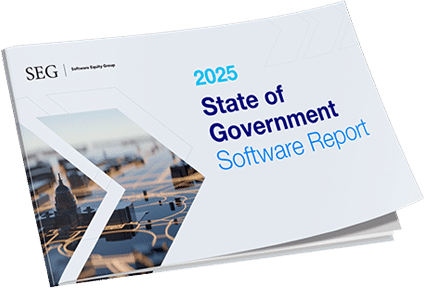You’re considering a merger or acquisition, and you may have even received offers. At the same time, you need to stay focused on running your company, efficiently growing your business, and retaining your existing customers to ensure the opportunity remains attractive to private equity investors or strategic buyers.
What to Expect in the M&A Process
Navigate Challenges with a Strategic M&A Advisor

The Value You Expect. The Outcome You Deserve.
An experienced M&A advisor can help you position your company in a way that will appeal to buyers and create a competitive market that maximizes value so you get the best possible outcome. Software Equity Group focuses exclusively on sell-side majority transactions and employs a high-touch process that adds value at every stage. We drive stellar outcomes for our clients while maintaining strong relationships with our deep network of buyers.
In this overview, you’ll discover the different types of M&A processes, key milestones in an M&A transaction and how a strategic advisor can help you clear each hurdle.
Types of M&A Processes
There are several types of M&A processes you may want to consider depending on your company’s goals, whether you have existing offers on the table, and other factors that may impact how quickly you want to act. Our team will help you choose the process that will bring you the best outcome given those factors.
We’ve structured our M&A process in a way that allows us to dynamically shift depending on your goals and real-time feedback from the market. We may start with a broad process that involves casting a wide net of potential buyers, but we can quickly narrow that down to a more targeted list of buyers or a single buyer should a buyer attempt to put forth a preemptive offer.

Running a Broad M&A Process
Strong software companies with the right metrics can command premium outcomes, even in times of economic uncertainty. Founder-led software companies typically maximize the possibility of achieving the best outcome when they take the time to properly position their business within the context of the larger market and cast to a wide net of potential buyers. That requires a deep understanding of market trends, buyer activity and valuation drivers, which takes years to develop.
Timeline 6-9 months

Bidding for Selected Strategic & Financial Buyers
Managing a limited bidding process requires tremendous focus and attention to detail, which can take away from your ability to effectively run your business and optimize performance. If you have an existing list of potential buyers, we can help you run an efficient bidding process to maximize valuation and close the deal in the most efficient manner.
Bidding for Targeted Strategic Buyers
If you have a more targeted list of strategic buyers, our team will conduct a small bidding process between the top prospective buyers and rely on our exceptional negotiation skills to drive competition.
Direct Negotiation
Even if you already have an interested party or several offers and you’re ready to move forward with one deal, you still need to ensure you’ve structured the letter of intent (LOI) and purchase agreement properly and you have a dedicated team to perform the labor-intensive document reviews required to mitigate risks during due diligence. We can manage this process, reducing risk and the time it takes to close. This includes coordinating business, accounting, legal and other reviews and managing multiple workflows at the same time.
The Broad M&A Process Timeline
Running a broad M&A process involves casting the widest net of potential strategic and financial buyers to maximize competition. This process takes more time but often leads to the most successful outcomes. Here’s a closer look at a typical timeline and how our team adds value at each stage.

4-8 weeks
- Review strategy and timing
- Advisor due diligence
- Prepare teaser and memorandum
- Finalize financial model
- Finalize buyer/investor list
5-7 weeks
- Contact buyers/investors, send out teaser and NDA
- Provide memorandum
- Prepare management presentation
Indications
2-3 weeks
- Solicit initial indications of interest
- Enter second round of discussions and select parties for management meetings
- Answer follow-up questions
4-6 weeks
- Hold management presentations
- Provide access to data room
- Formalized process for additional diligence requests
- Begin detailed business, financial, legal, tax and accounting due diligence
Detailed Bids
2-3 weeks
- Evaluate and negotiate by playing interested parties against each other
- Choose best options
- Draft purchase agreement and related documents
Negotiation
M&A Strategy
- Confirmatory due diligence
- Final contract negotiations and documentation
- Close and announce transaction
M&A Deal Preparation
Research and positioning
Anyone can gather financial information, but analyzing it and presenting it in a compelling way that resonates with buyers requires skill and expertise.
Our team conducts an in-depth analysis of your business and your competitors within the larger market. While we develop a thorough understanding of your core competencies, product roadmap and finances, we use those findings to position your company in a clear, concise manner.
You may have a dozen different lines of business, but an investor’s ability to quickly understand your differentiators within the market and the opportunities ahead can make a significant difference in the level of interest and efficiency of the M&A process.


We figured if we didn’t do a whole lot of work, we could probably sell our company for $30-$35 million. But the process, the fine-tuning, distilling the message and marketing to the right folks, that is what got us from, say, $35 million to $50 million. And that’s all a byproduct of the work that SEG did.”
Confidential information memorandum
Developing a confidential information memorandum (CIM) is essential for positioning your company as an attractive opportunity to buyers and investors. A well-crafted CIM generates more interest from potential buyers to increase competition and gives prospective buyers a clear picture of your operations and finances so they can evaluate the opportunity, ultimately maximizing value. It can also reduce the chances of the deal being renegotiated or falling through by disclosing and providing context around important information early in the M&A process.
The CIM should be tailored to capture the entire audience, whether you’re looking for a strategic buyer interested in your business to fill a need or a financial buyer looking to build their investment portfolio.
In general, a CIM includes these main sections:
- 1. A business summary
- 2. An overview of the competitive landscape
- 3. A product overview
- 4. A customer overview
- 5. Growth opportunities ahead
- 6. Financial Overview
- 7. Ownership & organization overview
Creating a Market
After the CIM is complete, we develop a strategy to reach out to investors and strategic buyers with a teaser that presents the opportunity without any identifiable information about your company.
Having a mix of both types of buyers drives competition but also requires thoughtful, intentional outreach. Our goal is to identify strategic buyers who complement your existing products and include the right list of investors that fit your business and goals.
Our team draws from our extensive network of strategic buyers and private equity firms to identify buyers from other product categories, markets or geographies. About a fourth of the deals we execute are with buyers the seller did not know prior to engaging with us.

Marketing and Indication of Interest (IOI) - First Round Bids
Research and Marketing the Deal
For a broad process, our team begins with outreach to promote the opportunity to potential buyers with the aforementioned teaser, driving towards getting NDA’s executed with interested parties in order to share the CIM. SEG remains in constant contact with the buyer community, scheduling calls to answer questions, discuss process and next steps, assess level of interest, and qualify buyers.
During this time, founders & their management teams may meet with select parties, who will begin to ask questions about the opportunity. As M&A advisors, our team will coach you through this process to help you anticipate these questions and answer them with confidence.

Reviewing First-Round Bids
You and other key decision makers will review the first round of bids and, with our commentary and background, select buyers to advance to the next round, where they will submit a more formal letter of intent (LOI). Throughout the M&A process, it’s crucial to stay in control of all communications with external parties and avoid disclosing certain types of information. Our experienced M&A advisors know what is appropriate to share at each stage to maintain the strongest position during negotiations.
Managing Data Room Access
During this time, interested parties also receive access to a data room so they can begin to review financial information and populate their valuation models. Our team closely monitors how these prospects interact with the documents in your data room so we can further gauge interest and anticipate questions. We have over two decades of experience working with private equity firms, and we can identify genuine interest based on what we know about how individual firms operate.

Working with an advisor gives you a lot more opportunities you would otherwise not have. We were able to give demos to some really big name software companies and get them interested in our company. Had I done this on my own, that would not have been the case.”
Round 2: Letter of Intent
Coordinate Additional Meetings
During the second-round bid stage of the M&A process, we will coordinate additional meetings based on functions such as sales & marketing, product & technology, financial & customer, and any other functional breakouts. We will also provide more specific follow-up materials to a much smaller group of select buyers. This may include sharing a quality of earnings analysis and technology reviews to drive value, minimize risk for the buyer, and increase competition. By this stage, you will be receiving many detailed questions and requests for information from prospective buyers. Without a trusted advisor to manage this process, it becomes extremely difficult to respond in a timely manner and avoid jeopardizing the deal.
We work closely with your team to address buyers’ questions with consistent messaging.

Selecting final bids
After buyers submit LOI’s, we will then work with you to select final bidders. At this stage, having an M&A advisor who can aggressively negotiate on your behalf regarding valuation and key terms is integral.
Due Diligence
Our entire M&A process is designed to minimize risk so there are no surprises for either party by the time they reach this final stage: due diligence. The goal of due diligence is for the buyer to confirm the facts, information, and assumptions to support their LOI and interest in acquiring the business, as well as for legal teams to work through the iterative process of the purchase agreement.
Managing the sheer volume of documents and coordinating with the various parties who need to review them is a tedious process that will be exceptionally challenging for a software founder or CEO who is focused on running their company.
During due diligence, the buyer will review all risks and agreements that could impact liability. It’s a collective effort between many parties, including lawyers, accountants, tax and finance experts, technology directors and your company’s leadership team, as well as the buyer’s team of experts.

Due diligence for software companies typically falls under six categories:
Our team’s deep expertise with sell-side software M&A enables us to identify issues that could put your company at risk.
For instance, improper revenue recognition in a software-as-a-service model can lead to investors devaluing your company. Having independent contractors who claim ownership of your company’s intellectual property could even derail the deal.
An M&A advisor can also recommend proactive steps you can take before you reach the due diligence stage to make the process as seamless as possible.
For instance, reviewing all your customer contracts can be a time-consuming undertaking if you haven’t structured them in a consistent, organized manner.

You’ll need to review contracts, start dates, end dates, whether you need consent and connection with the change of control, favored pricing provisions, non-competes, caps on indemnity. Buyers like to see provisions that say you can’t be liable for consequential damages. You can’t be liable for more than the customer paid you.”
Start your M&A journey on the right foot with SEG
Whether you’re in direct negotiation with a single buyer or contemplating running a broad M&A process, it’s difficult to manage the M&A process without the right strategy and team. Even the most well-known PE firms hire an advisor to help them coordinate the legal and financial aspects of an acquisition they’ve made because they know it’s a far more efficient way to maximize value while mitigating risk.
Founders or CEOs who go through the M&A process alone often leave millions of dollars on the table because they haven’t positioned the business correctly, driven competitive tension, or properly negotiated. Some even see deals fall through after spending many months on the process while losing focus on business operations.
SEG provides value at every stage in the M&A process that ultimately leads to strong outcomes for our clients.

When you’re running a company and your management team is in that operational hamster wheel, you can tell a story, but it’s really from your operational lens. What SEG (showed us) was the 30,000-foot view of why that’s important, why that’s unique, and had us thinking bigger.”



